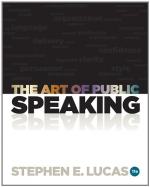Some Purposes of Exposition
From what has been said it ought to be clear that, primarily, exposition weaves a cord of understanding between you and your audience. It lays, furthermore, a foundation of fact on which to build later statements, arguments, and appeals. In scientific and purely “information” speeches exposition may exist by itself and for itself, as in a lecture on biology, or on psychology; but in the vast majority of cases it is used to accompany and prepare the way for the other forms of discourse.
Clearness, precision, accuracy, unity, truth, and necessity—these must be the constant standards by which you test the efficiency of your expositions, and, indeed, that of every explanatory statement. This dictum should be written on your brain in letters most plain. And let this apply not alone to the purposes of exposition but in equal measure to your use of the
Methods of Exposition
The various ways along which a speaker may proceed in exposition are likely to touch each other now and then, and even when they do not meet and actually overlap they run so nearly parallel that the roads are sometimes distinct rather in theory than in any more practical respect.
=Definition=, the primary expository method, is a statement of precise limits.[15] Obviously, here the greatest care must be exercised that the terms of definition should not themselves demand too much definition; that the language should be concise and clear; and that the definition should neither exclude nor include too much. The following is a simple example:
To expound is to set forth
the nature, the significance, the
characteristics, and the bearing
of an idea or a group of ideas.
—ARLO BATES, Talks on Writing English.
=Contrast and Antithesis= are often used effectively to amplify definition, as in this sentence, which immediately follows the above-cited definition:
Exposition therefore differs
from Description in that it deals
directly with the meaning
or intent of its subject instead of
with its appearance.
This antithesis forms an expansion of the definition, and as such it might have been still further extended. In fact, this is a frequent practise in public speech, where the minds of the hearers often ask for reiteration and expanded statement to help them grasp a subject in its several aspects. This is the very heart of exposition—to amplify and clarify all the terms by which a matter is defined.
=Example= is another method of amplifying a definition or of expounding an idea more fully. The following sentences immediately succeed Mr. Bates’s definition and contrast just quoted:




